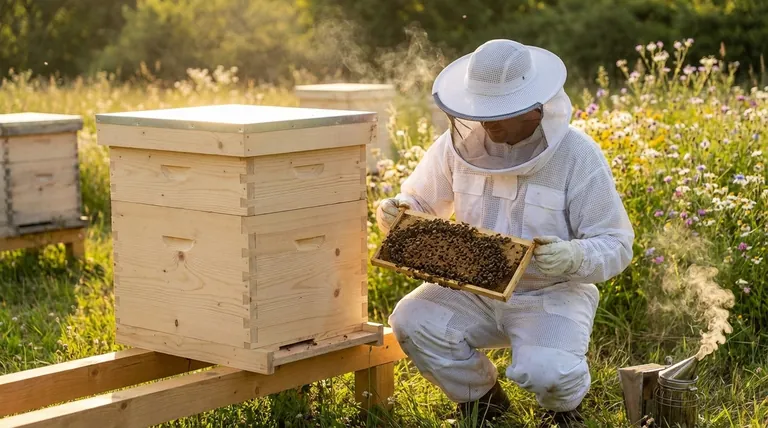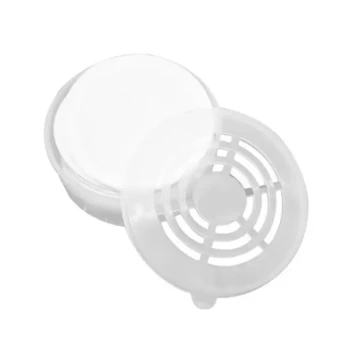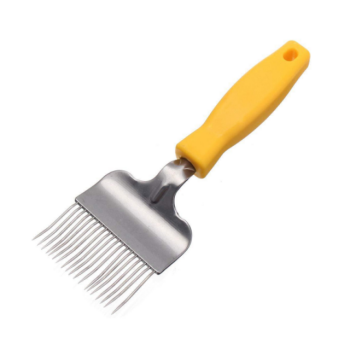The primary advantages of a beekeeping suit are comprehensive physical protection and the psychological confidence that comes with it. A full suit creates an effective barrier against bee stings from head to toe, which is especially valuable for new beekeepers who may feel nervous. This sense of security helps them remain calm, making for a safer and more productive interaction with the hive.
The decision to wear a beekeeping suit is not just about preventing stings; it's about managing risk and mindset. While a full suit offers the highest level of protection, the real benefit is the confidence it provides, allowing you to focus on the health of your bees without anxiety.

The Core Benefits of a Full Suit
A full beekeeping suit is designed to be a complete protective system. Its value goes beyond simply stopping a bee's stinger.
Comprehensive Sting Prevention
A one-piece suit ensures there are no gaps at the waist where a bee could crawl inside. This seamless coverage is a significant advantage over separate jackets and pants.
High-quality suits feature elastic cuffs at the wrists and ankles, creating a secure seal that prevents bees from accessing your skin. This is critical for maintaining a completely protected environment.
Building Confidence for Beginners
Bees are known to sense tension and agitation in a beekeeper. By eliminating the fear of stings, a full suit helps you remain calm and move deliberately.
This confidence is not just a feeling; it translates into better beekeeping. A relaxed beekeeper is less likely to make sudden movements that could alarm the hive.
Protection Beyond the Bees
Working with bees can be messy. A suit keeps sticky propolis and wax off your personal clothing, making cleanup much easier.
The full-coverage design also provides excellent sun protection during long hours spent inspecting hives outdoors.
Understanding the Trade-offs: Suit vs. Jacket
While a full suit offers maximum protection, it's not the only option. Many beekeepers choose a beekeeping jacket for specific reasons.
The Suit: Maximum Security
A full suit is the gold standard for complete protection. It is the recommended choice for anyone new to beekeeping or those working with a particularly aggressive hive.
The all-in-one design removes any doubt about potential exposure points, offering true peace of mind.
The Jacket: Convenience and Comfort
A beekeeping jacket is much faster to put on and take off, functioning much like a simple hoodie. This convenience is a major benefit for quick hive checks.
Jackets are also less cumbersome and lighter than a full suit, which can be a significant advantage during hot weather.
Factoring in Climate
Both suits and jackets are now commonly available in ventilated materials. These designs, often using a triple-layer mesh, allow for far better airflow while still preventing stings.
Choosing a ventilated option, whether a suit or a jacket, is essential for comfort in warmer climates.
Making the Right Choice for Your Goal
Your ideal protective gear depends on your comfort level, climate, and beekeeping style.
- If your primary focus is maximum safety and peace of mind: A full beekeeping suit is the definitive choice, especially when you are just starting out.
- If your primary focus is quick inspections in hot weather: A high-quality ventilated jacket provides an excellent balance of protection and comfort.
- If your primary focus is a professional, long-term investment: A durable, well-made suit from a reputable brand will provide reliable protection for many seasons.
Ultimately, choosing the right gear is about enabling you to be a calm, confident, and effective beekeeper.
Summary Table:
| Benefit | Key Feature | Ideal For |
|---|---|---|
| Comprehensive Protection | One-piece design with elastic cuffs | New beekeepers, aggressive hives |
| Beginner Confidence | Reduces anxiety, promotes calm movements | Anyone starting their beekeeping journey |
| Added Durability | Shields clothing from propolis and wax | All beekeepers for easier cleanup |
Ready to work with your bees confidently and safely?
HONESTBEE supplies professional-grade beekeeping suits and equipment designed for the demands of commercial apiaries and distributors. Our suits provide the maximum protection and durability you need for efficient, worry-free hive management.
Contact our wholesale team today to discuss your apiary's needs and discover how our equipment can support your operation's success.
Visual Guide

Related Products
- Wholesales Dadant Size Wooden Bee Hives for Beekeeping
- Yellow Plastic Bucket Pail Perch for Beekeeping
- Long Langstroth Style Horizontal Top Bar Hive for Wholesale
- Professional Insulated Plastic Bee Hives
- Professional Insulated Winter Hive Wrap for Beekeeping
People Also Ask
- What are the essential pieces of equipment for most beekeepers? Get Started with the Right Gear
- Why were wooden hives traditionally preferred? For Natural Beekeeping Aligned with Bee Biology
- How often should the area under beehives be inspected and cleaned during the warm season? A Proactive Maintenance Guide
- What types of products are available for beekeeping needs? Essential Equipment for Apiaries & Distributors
- What is the best place to keep bees? Find the Perfect Apiary Site for Your Hives



















